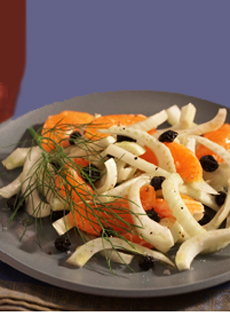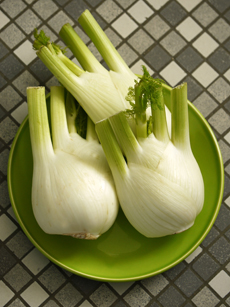RECIPE: Orange Fennel Salad
|
We were looking for something new and special in a salad and came across this easy recipe from Tom Fraker, corporate chef at Melissas.com.
At Melissa’s, Tom has every type of special fruit and vegetable at his disposal. Instead of orange segments, he used seedless Ojai Pixie tangerines in this recipe. You can use whatever tangerines or oranges you can find locally (or treat yourself to some Ojai Pixies from Melissa’s). The benefit of tangerines over oranges is that the segments are smaller and can be eaten in one bite. We like the contrast of sweet and tangy, so substituted the dried blueberries for sliced black olives. TANGERINE & FENNEL SALAD Ingredients For 4 Servings |
 Tangerine and fennel salad, a flavorful combination. Photo courtesy Melissas.com. |
|
|
1. Place the first 3 ingredients in a bowl and toss to incorporate. 2. In another bowl, whisk together the vinegar and olive oil. Add to the salad, toss, and season with salt and pepper. 3. Garnish with the fennel tops (leaves). Save extra leaves for garnishing another dish. |
||
 Fennel with the tops (leaves) trimmed. Save the feathery leaves as garnish. Photo by Max Straeten | Morguefile. |
FENNEL FACTS A member of the parsley family, fennel (Foeniculum vulgare) may look like celery (Petroselinum crispum), but is actually a perennial herb, indigenous to the shores of the Mediterranean. They are botanical cousins, members of the same order (Apiales) and family (Apiaceae). Records of fennel’s use date back to about 1500 B.C.E, although it has been enjoyed by mankind for much longer. Fennel is highly aromatic and flavorful, with both culinary and medicinal uses. The bulb and stalks resemble celery, the leaves look like dill (Anethum graveolens, also of the same order and family), and the aroma and flavor resemble sweet licorice (Glycyrrhiza glabraa, a totally different order [Fabales] and family [Fabaceae]). |
|
|
Fennel can be substituted for celery in recipes when an additional nuance of flavor is desired. We also enjoy it as part of a crudité plate. Plain and sugar-coated fennel seeds are used as a spice and an after-meal mint in India and Pakistan. |
||


